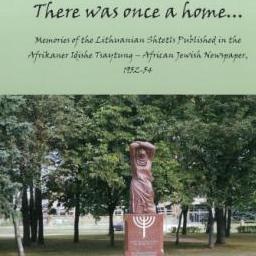
Lifestyle/Community

Yiddish articles now accessible in English
MOIRA SCHNEIDER
CAPE TOWN
Pictured: The cover of “There was once a home”, a collection of articles on life in the Lithuanian shtetls, translated from the Yiddish by Dr Veronica Belling.
Published as a series of articles between 1952 and 1954, in a first for this genre, the stories and anecdotes have been translated by Dr Veronica Belling and serve as a poignant memento for the South African Jewish community of its Lithuanian roots.
Belling, who was the Jewish Studies librarian at the Kaplan Centre for 31 years, studied Yiddish on the Uriel Weinreich Yiddish Summer Programme under the auspices of the Yivo Institute for Jewish Research and Columbia University in New York.
The book affords one glimpses of the religious and secular life in the 25 featured shtetls, including Shidlova, Rakishok, Oran, Poshelat, Ponevezh, Kupishok and Birzh, among others. Descriptions relate to the period 1918 – 1940 and are illustrated with photographs that, together with information, were sent in by readers of the newspaper.
Belling has also included photographs of Jewish sites and memorials that she took on a tour to Lithuania in 2013 that included 13 of the 25 towns mentioned in the book.
It is, however, the inclusion in all too many captions of the simple words, “The majority in the photo perished” that drives home the reality of the destruction of 90 per cent of the 220 000-strong Jewish community during the Holocaust, more than any elaborate descriptions could.
The main focus of the articles is on the people who lived in the shtetls. Also reflected is the richness of communal and cultural life, with Zionist societies constituting the largest political grouping.
One reads of the “first lady” of Kurshan, a Mrs Gelbart, whose husband was the director of the Jewish People’s Bank. “She was a milliner by trade, who was involved in fashion so that the whole atmosphere in her home was very modern, very European.
“Moreover, Mrs Gelbart was also an exceptionally beautiful woman with excellent taste and true European manners. The secular intelligentsia of the shtetl used to gather in and around the Gelbart home, because in the same way that the rabbi’s home was an expression of religious Zionism, the Gelbart’s home was a synonym for Jewish worldliness.
“Both small worlds, however, lived in harmony in the small world of the shtetl in true friendship and deep mutual respect.”
While the support from Africa was a great help to many families in Lithuania in the years leading up to the Second World War, this was particularly the case for the Jews from Krakinova, where the majority survived thanks to this help.
“The Jews of Africa exported pounds to the shtetl, but in turn they imported Jewish spirituality, warm bonds, and a great deal of love that was conveyed in heart-warming letters and close family ties,” writes A Sarid, the initiator of the project and author of the majority of the articles, who lived in Lithuania until approximately 1942 before emigrating to this country.
In the tiny shtetl of Vashki lived a Dr Ganandski who “would travel for miles to attend to a wretched peasant couple, in rain or snow… The doctor doesn’t ask for money. The peasants know that he will accept whatever they are able to pay him.”
For his trouble, the beloved doctor lies buried in a mass grave along with all the Jews of Vashki, murdered by the very people he had helped.
“There was once a home” is published by the Isaac and Jessie Kaplan Centre for Jewish Studies and Research and is available at the South African Jewish Museum shop. E-mail: info@sajewishmuseum.co.za




